| Author | Message | ||
| chalkie
New Username: chalkie Post Number: 2 Registered: 6-2009 |
I've just bought a 1982 distiller 82D2131. the electronics seem slightly odd though: one of the switches isn't right. I think it should be a 3-position bass cut/straight/boost, but it seems to be just a straight/boost 2-position switch. Also, the wiring on the Q-switch seems a bit odd; the switch appears to be a single-pole double-throw, but the centre lug has no electrical connection to it! (and toggling it makes no discernible difference) Looks like someone has had some fun electrically with this guitar in the past. I'd like to get it back to standard :-) (Message edited by chalkie on June 16, 2009) | ||
| mario_farufyno
Intermediate Member Username: mario_farufyno Post Number: 120 Registered: 9-2008 |
This one seems to work like Europa/Rogue's Q switch. It just works as plain or 8 dB boost at cut off frequency... Nothing wrong. | ||
| mario_farufyno
Intermediate Member Username: mario_farufyno Post Number: 121 Registered: 9-2008 |
Spoillers are like that, too. Check Distillate's specs at FAQ & Must Reads | ||
| mica
Moderator Username: mica Post Number: 6181 Registered: 6-2000 |
There should be one 2-position switch for the Q function and two 3-position switches for the bass and treble cut/flat/boost functions. Just flicking the Q switch on a sustained note doesn't make much audible difference. To hear the Q working, put the Q switch in the down (boosted) position, sustain a note and then rotate the filter control back and forth. You should hear a distinct "wah-wah" as you sweep through the frequencies. In the up (dampened) position, the filter response is flat. Another way to hear what the Q is doing is to play a passage that you are really good at repeating, once with the Q up and once with the Q down. Concentrate on listening to the attack of the note. When the Q switch is in the boosted position, you'll hear a sharper attack on the note. As a gross generalization, you'll probably play blues, ballads, some jazz with the Q switch in the dampened position (up), while with slap, rock, metal you'll probably use the Q in the boost position (down). It's a starting point anyway. Check that there isn't a jumper from one of the end lugs to the center lug on the Q-switch. Post clear pictures when you get a chance. | ||
| chalkie
New Username: chalkie Post Number: 5 Registered: 6-2009 |
OK, here's a first go at some pictures. Bass boost external view 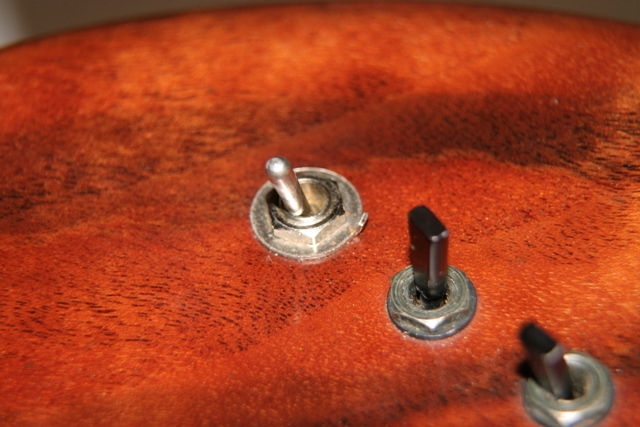 Bass boost internal view Its a double-poll double-throw switch. I may need to remove the electronics to show a better layout, because the switch is largely obscured by those huge capacitors & resistors  Q switch internal view 1. Veroboard ?? 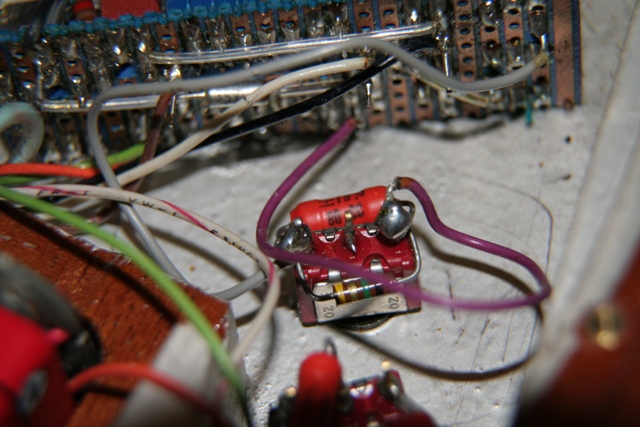 Q switch internal view 2 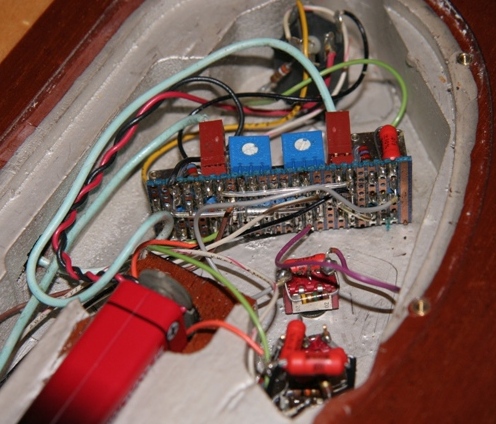 Tailpiece surface corrosion 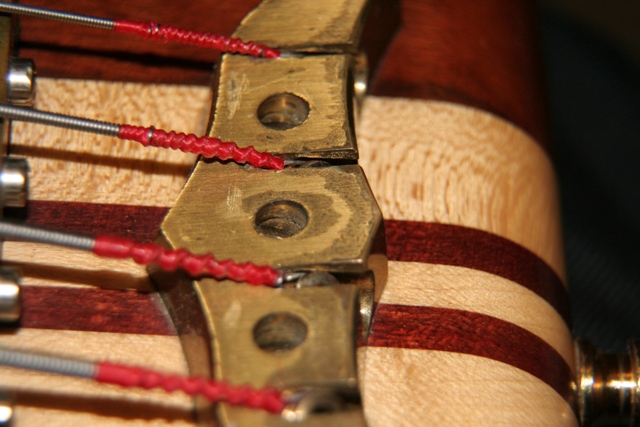 Serial (sorry, focus is slightly off but its legible enough) 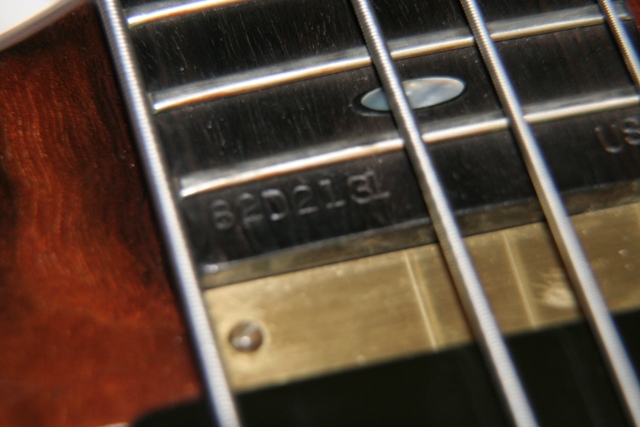 | ||
| mica
Moderator Username: mica Post Number: 6184 Registered: 6-2000 |
Here's the proper Q-switch connections:  So move that violet wire to the center and your Q should do it's job. The other two switches should be 3-position. Can you read the numbers stamped on the side of the switch? Yup, that's Veroboard - handwired by my grandmother no doubt. For the tailpiece, corrosion has crept under the polyester finish, so about the only remedy there is to take the tailpiece off, sand away the coating, then buff to a polished finish. It will tarnish, but you can clean it, where now, you can't get under the polyester to clean up the tarnish. | ||
| altgrendel
Member Username: altgrendel Post Number: 92 Registered: 5-2008 |
Yup, that's Veroboard - handwired by my grandmother no doubt. I'm impressed! o_O | ||
| chalkie
New Username: chalkie Post Number: 7 Registered: 6-2009 |
Yep, your wiring sure makes more sense than I have currently installed!! For what its worth, I had half-guessed that the violet wire should go to the centre. My other guess is that is was moved for a reason - possibly the switch itself is faulty. I'll try moving it back and see what happens. For what its worth, my family background is electronics engineering, and my saturday job as a kid was soldering PCBs for my dad's company. Ever heard of "Bad Boys Rape Our Young Girls, But Virgins Go Without" ? If its not one you know, there's a clue in Mica's photo. | ||
| mica
Moderator Username: mica Post Number: 6186 Registered: 6-2000 |
I learned it as "...But Violet Goes Willingly" | ||
| chalkie
New Username: chalkie Post Number: 9 Registered: 6-2009 |
yeah, when I googled it I found that the common modern version is "Bad Boys Ravish Our Young Girls, But Violet Goes Willingly". The one I learnt was from my dear old dad probably 40 years ago, and I suppose he'll have had that version for some time by then. He said that it was used by the RAF engineers. | ||
| altgrendel
Member Username: altgrendel Post Number: 94 Registered: 5-2008 |
For those wondering what the heck they're talking about, go here It's at the end of the page. | ||
| adriaan
Senior Member Username: adriaan Post Number: 2246 Registered: 6-2002 |
Or perhaps here. | ||
| terryc
Senior Member Username: terryc Post Number: 909 Registered: 11-2004 |
Okay..what is does this one signify and stand for Richard Of York Goes Battling In Vain No prizes unfortunately | ||
| dannobasso
Senior Member Username: dannobasso Post Number: 1047 Registered: 3-2004 |
Spectrum colors. | ||
| lbpesq
Senior Member Username: lbpesq Post Number: 3939 Registered: 7-2004 |
My Very Educated Mother Just Served Us Nine Pickles. (though the scientists recently told us there really is no "pickles") Bill, tgo | ||
| chalkie
New Username: chalkie Post Number: 10 Registered: 6-2009 |
Its resistor colour coding. From 0-9 it goes Black,Brown,Red,Orange,Yellow,Green,Blue,Violet,Grey,White. hold it the right way around, and you can read its resistivity. There's more to it than just that, 'cos you've got multiplier, tolerance and quality, but anyway that's the topic here. | ||
| chalkie
Junior Username: chalkie Post Number: 11 Registered: 6-2009 |
Ever get the feeling you wished you'd stayed on subject? Terry mate, Your head is in a rainbow. Bill, What planet are you on? ;-) | ||
| chalkie
Junior Username: chalkie Post Number: 13 Registered: 6-2009 |
OK, I moved the violet wire to the centre lug. Blimey, what a difference. I suppose that the way it was the Q switch was permanently in the "off" position. With the switch on, I get exactly the wah-wah sound you described when I rotate the filter pot, and in any case I can really hear the difference in the shape of the note. There seems to be a fairly small section of the rotary control which makes a very large change to the quality of the note though. I wonder if there is a way to smooth that out? Anyhow, now I can get that great sound I've been after  The one that sounds like you're playing down a huge drainpipe, a special acoustic drainpipe built for the purpose. Its not a dry pipe though, it has a lovely wet quality. The switch wasn't faulty either; it works just fine. The one that sounds like you're playing down a huge drainpipe, a special acoustic drainpipe built for the purpose. Its not a dry pipe though, it has a lovely wet quality. The switch wasn't faulty either; it works just fine. While I had the back off, I dismounted the bass & treble boost switches so that I could see the wiring better than in the photos above (Bass boost internal view). The treble switch is a C&K 7103 which looks like the other switches you use. The bass switch just has the number T228 printed on it which I couldn't identify. It looks like a fairly standard DPDT good quality switch. I sketched the wiring and I'll try to put that into something I can upload. I've also found that the truss rod on the G side of the neck needed about a half-turn of tightening to bring the neck back to roughly true. I'll leave it like that for now and see if it wanders any more. I've been trying to fine-tune the intonation, and I'm pretty close. I'm starting to get really happy with this guitar now, although I think I need to get one of these strobe tuners to move up a gear in the precision stakes. Also, while I'm on the subject of pots, both pots are very slack, by which I mean there is almost no resistance to rotation, and the slightest touch will alter their position. Is there a way to increase the friction on the pots, or am I looking at replacements? I see that the filter pot is double-ganged, so that'll be a bit more fun to de-solder. | ||
| davehouck
Moderator Username: davehouck Post Number: 8244 Registered: 5-2002 |
Charlie; you may want to try placing a felt pad between the bottom of the knob and the body. | ||
| lbpesq
Senior Member Username: lbpesq Post Number: 3941 Registered: 7-2004 |
Charlie: Not Pickles (anymore). Bill, tgo | ||
| chalkie
Junior Username: chalkie Post Number: 15 Registered: 6-2009 |
Dave, I have a bad mind. As soon as I read your answer I thought "incontinence pad". I'm sorry. Bill, I think we should start a "Save the Pickles" society. See who gets it. | ||
| adriaan
Senior Member Username: adriaan Post Number: 2250 Registered: 6-2002 |
The problem is of course confounded by the fact that Nine is now Eight. | ||
| mica
Moderator Username: mica Post Number: 6200 Registered: 6-2000 |
The early Clarostat pots did not have an internal wave washer, which serves the dual purpose of allowing the use of metal knobs without static, and also increase mechanical friction. I'm afraid that unless you can fine tune the feel with the felt washer as Dave suggested, you're looking at replacements, which may be a bigger job than resoldering if you've currently got 1/8" shaft pots, which is probable. Try rotating the filter pot back and forth fully through the rotation (reaching both ends each time), a good 30-50 times. The pots are sealed and self-clean, but they need to be exercised to effect the cleaning. Glad you go to hear what the Q does in the boost position. | ||
| dela217
Senior Member Username: dela217 Post Number: 968 Registered: 6-2002 |
Bill, Being 50 I still consider the pickle as one. My son who is 11 fights me about it. Michael | ||
| chalkie
Junior Username: chalkie Post Number: 16 Registered: 6-2009 |
OK, here's my first go at the wiring I find for the bass & treble boost switches on my distiller. I believe that the treble boost (7103) is stock, and works correctly so far as I know. The bass boost switch (T228) is a non-standard DPDT switch in silver.  |